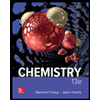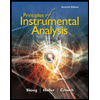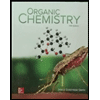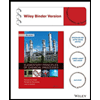
GENERAL,ORGANIC,+BIOCHEMISTRY(LL)-PKG
10th Edition
ISBN: 9781260699227
Author: Denniston
Publisher: MCGRAW-HILL HIGHER EDUCATION
expand_more
expand_more
format_list_bulleted
Question
Chapter 13.1, Problem 13.3Q
(a)
Interpretation Introduction
Interpretation:
Among propionic acid and propionaldehyde, the member that would have higher boiling point has to be given.
(b)
Interpretation Introduction
Interpretation:
Among acetic acid and acetone, the member that would have higher boiling point has to be given.
Expert Solution & Answer
Want to see the full answer?
Check out a sample textbook solution
Students have asked these similar questions
Hello please, draw the main product in the following reactions:
Please
Draw the structure that corresponds to each of the following names:
1-(2-bromopropyl)-3-tert-butyl-6-ethyl-4-methylcyclohexa-1,4-diene
Please calcula the degrees of unsaturation for the following molecular formula: C6H7NF2. Draw two different compounds with this same molecular formula
Chapter 13 Solutions
GENERAL,ORGANIC,+BIOCHEMISTRY(LL)-PKG
Ch. 13.1 - Which member in each of the following pairs will...Ch. 13.1 - Which member in each of the following pairs will...Ch. 13.1 - Prob. 13.3QCh. 13.1 - Prob. 13.4QCh. 13.2 - Prob. 13.1PPCh. 13.2 - Prob. 13.2PPCh. 13.2 - Prob. 13.3PPCh. 13.2 - Prob. 13.4PPCh. 13.2 - Prob. 13.5QCh. 13.2 - Write the condensed formula for each of the...
Ch. 13.2 - Prob. 13.7QCh. 13.2 - Write the condensed formula for each of the...Ch. 13.3 - Draw the structure of the aldehyde synthesized...Ch. 13.3 - Prob. 13.10QCh. 13.4 - Prob. 13.5PPCh. 13.4 - Prob. 13.6PPCh. 13.4 - Prob. 13.7PPCh. 13.4 - Prob. 13.8PPCh. 13.4 - Prob. 13.11QCh. 13.4 - Prob. 13.12QCh. 13.4 - Identify each of the following structures as a...Ch. 13.4 - Identify each of the following structures as a...Ch. 13.4 - Prob. 13.9PPCh. 13 - Prob. 13.15QPCh. 13 - Prob. 13.16QPCh. 13 - Prob. 13.17QPCh. 13 - Prob. 13.18QPCh. 13 - Prob. 13.19QPCh. 13 - Prob. 13.20QPCh. 13 - Prob. 13.21QPCh. 13 - Why do hydrocarbons have lower boiling points than...Ch. 13 - Prob. 13.23QPCh. 13 - Prob. 13.24QPCh. 13 - Prob. 13.25QPCh. 13 - Prob. 13.26QPCh. 13 - Prob. 13.27QPCh. 13 - Prob. 13.28QPCh. 13 - Draw each of the following using condensed...Ch. 13 - Prob. 13.30QPCh. 13 - Prob. 13.31QPCh. 13 - Prob. 13.32QPCh. 13 - Prob. 13.33QPCh. 13 - Prob. 13.34QPCh. 13 - Prob. 13.35QPCh. 13 - Prob. 13.36QPCh. 13 - Prob. 13.37QPCh. 13 - Prob. 13.38QPCh. 13 - Give the IUPAC name for each of the following...Ch. 13 - Give the IUPAC name for each of the following...Ch. 13 - Prob. 13.41QPCh. 13 - Prob. 13.42QPCh. 13 - Prob. 13.43QPCh. 13 - Prob. 13.44QPCh. 13 - Prob. 13.45QPCh. 13 - Prob. 13.46QPCh. 13 - Prob. 13.47QPCh. 13 - Prob. 13.48QPCh. 13 - Prob. 13.49QPCh. 13 - Prob. 13.50QPCh. 13 - Prob. 13.51QPCh. 13 - Prob. 13.52QPCh. 13 - Prob. 13.53QPCh. 13 - Prob. 13.54QPCh. 13 - Prob. 13.55QPCh. 13 - Prob. 13.56QPCh. 13 - Prob. 13.57QPCh. 13 - Prob. 13.58QPCh. 13 - Prob. 13.59QPCh. 13 - Prob. 13.60QPCh. 13 - Prob. 13.61QPCh. 13 - An unknown has been determined to be one of the...Ch. 13 - Prob. 13.63QPCh. 13 - Prob. 13.64QPCh. 13 - Prob. 13.65QPCh. 13 - Prob. 13.66QPCh. 13 - Which of the following compounds would be expected...Ch. 13 - Write an equation representing the reaction of...Ch. 13 - Prob. 13.69QPCh. 13 - Prob. 13.70QPCh. 13 - Prob. 13.71QPCh. 13 - Prob. 13.72QPCh. 13 - Prob. 13.73QPCh. 13 - Prob. 13.74QPCh. 13 - Prob. 13.75QPCh. 13 - Prob. 13.76QPCh. 13 - Prob. 13.77QPCh. 13 - Prob. 13.78QPCh. 13 - Prob. 13.79QPCh. 13 - Prob. 13.80QPCh. 13 - Prob. 13.81QPCh. 13 - Prob. 13.82QPCh. 13 - Prob. 13.83QPCh. 13 - Prob. 13.84QPCh. 13 - Prob. 1MCPCh. 13 - Prob. 2MCPCh. 13 - Prob. 3MCPCh. 13 - Prob. 4MCPCh. 13 - Prob. 6MCPCh. 13 - Prob. 7MCPCh. 13 - Prob. 8MCPCh. 13 - Design a synthesis for each of the following...Ch. 13 - Prob. 10MCPCh. 13 - Prob. 12MCP
Knowledge Booster
Learn more about
Need a deep-dive on the concept behind this application? Look no further. Learn more about this topic, chemistry and related others by exploring similar questions and additional content below.Similar questions
- Which is a bond-line drawing of (CH3)2CHCH2OC(CH3)3 a. b. CL d. d a barrow_forwardWhich of the compounds would have the weakest conjugate base? Post acetylene with a Ka = 1 X 10-25 2-chloroethanol with a Ka = 2 X 10-14 cyclohexanone with a Ka = 5 X 10-16 cyclopentadiene with a Ka = 1 X 10-15arrow_forwardIdentify the meso compound(s). OH OH I only Il only I and II I, II, and III II HO OH OHarrow_forward
- Which compound has the highest boiling point? Q= OH OHarrow_forwardWhat is/are the major product(s) of this reaction? HBr (R)-3-bromo-2,3-dimethylpentane only (S)-3-bromo-2,3-dimethylpentane only a 50:50 mixture of (R) and (S)-3-bromo-2,3-dimethylpentane a 70:30 mixture of (R) and (S)-3-bromo-2,3-dimethylpentanearrow_forwardWhich energy diagram represents a two step reaction where the first step is the rate determining ste E E Reaction Coordinate A Reaction Coordinate C Do NOT Copy or Post OGMU OA OB Ос D E E M Reaction Coordinate B Reaction Coordinate D Aarrow_forward
- Give the best description for the regioselectivity and stereospecificity in the hydroboration-oxidation of an alkene. Markovnikov orientation with syn-addition Markovnikov orientation with anti-addition Anti-Markovnikov orientation with syn-addition Anti-Markovnikov orientation with anti-addition Markovnikov orientation with both syn- and anti-additionarrow_forwardWhich atoms can the negative charge on atom 3 be moved to using resonance theory? 4 6 8 CH 3 2 5 7 only 1, 5, 7 only 2, 4, 6 only 5, 8 only 1 only 2,4arrow_forwardO What is the major product of this reaction? OTS NaOEt OEt OEt ACMUAvousernkarrow_forward
- All of the following are more acidic than water (H2O) EXCEPT: a. H d. HO a OH OHarrow_forwardWhat type of reaction steps are represented below? OH H-Br LB = Time Remaining H = H nucleophilic attack, followed by proton transfer proton transfer, followed by loss of a leaving group proton transfer, followed by nucleophilic attack loss of a leaving group, followed by loss of a leaving group H₂O:arrow_forwardIf the 2 in 1 parenteral nutrition order provides 1678 kilocalories daily, what rate ml/hr should the md recommend for the Intralipid to provide the remaining daily kilocalories? Lipid: 10% Intralipids, infuse daily over a 12 hour period at a sufficient rate to provide remaining caloriesarrow_forward
arrow_back_ios
SEE MORE QUESTIONS
arrow_forward_ios
Recommended textbooks for you
 ChemistryChemistryISBN:9781305957404Author:Steven S. Zumdahl, Susan A. Zumdahl, Donald J. DeCostePublisher:Cengage Learning
ChemistryChemistryISBN:9781305957404Author:Steven S. Zumdahl, Susan A. Zumdahl, Donald J. DeCostePublisher:Cengage Learning ChemistryChemistryISBN:9781259911156Author:Raymond Chang Dr., Jason Overby ProfessorPublisher:McGraw-Hill Education
ChemistryChemistryISBN:9781259911156Author:Raymond Chang Dr., Jason Overby ProfessorPublisher:McGraw-Hill Education Principles of Instrumental AnalysisChemistryISBN:9781305577213Author:Douglas A. Skoog, F. James Holler, Stanley R. CrouchPublisher:Cengage Learning
Principles of Instrumental AnalysisChemistryISBN:9781305577213Author:Douglas A. Skoog, F. James Holler, Stanley R. CrouchPublisher:Cengage Learning Organic ChemistryChemistryISBN:9780078021558Author:Janice Gorzynski Smith Dr.Publisher:McGraw-Hill Education
Organic ChemistryChemistryISBN:9780078021558Author:Janice Gorzynski Smith Dr.Publisher:McGraw-Hill Education Chemistry: Principles and ReactionsChemistryISBN:9781305079373Author:William L. Masterton, Cecile N. HurleyPublisher:Cengage Learning
Chemistry: Principles and ReactionsChemistryISBN:9781305079373Author:William L. Masterton, Cecile N. HurleyPublisher:Cengage Learning Elementary Principles of Chemical Processes, Bind...ChemistryISBN:9781118431221Author:Richard M. Felder, Ronald W. Rousseau, Lisa G. BullardPublisher:WILEY
Elementary Principles of Chemical Processes, Bind...ChemistryISBN:9781118431221Author:Richard M. Felder, Ronald W. Rousseau, Lisa G. BullardPublisher:WILEY

Chemistry
Chemistry
ISBN:9781305957404
Author:Steven S. Zumdahl, Susan A. Zumdahl, Donald J. DeCoste
Publisher:Cengage Learning

Chemistry
Chemistry
ISBN:9781259911156
Author:Raymond Chang Dr., Jason Overby Professor
Publisher:McGraw-Hill Education

Principles of Instrumental Analysis
Chemistry
ISBN:9781305577213
Author:Douglas A. Skoog, F. James Holler, Stanley R. Crouch
Publisher:Cengage Learning

Organic Chemistry
Chemistry
ISBN:9780078021558
Author:Janice Gorzynski Smith Dr.
Publisher:McGraw-Hill Education

Chemistry: Principles and Reactions
Chemistry
ISBN:9781305079373
Author:William L. Masterton, Cecile N. Hurley
Publisher:Cengage Learning

Elementary Principles of Chemical Processes, Bind...
Chemistry
ISBN:9781118431221
Author:Richard M. Felder, Ronald W. Rousseau, Lisa G. Bullard
Publisher:WILEY
07 Physical Properties of Organic Compounds; Author: Mindset;https://www.youtube.com/watch?v=UjlSgwq4w6U;License: Standard YouTube License, CC-BY